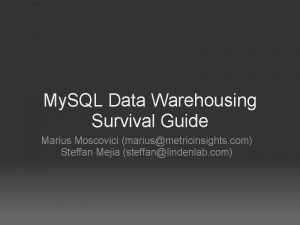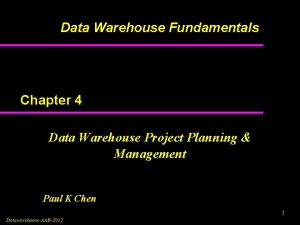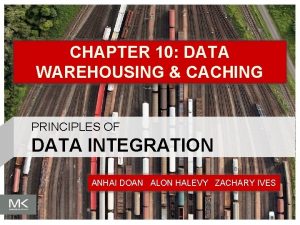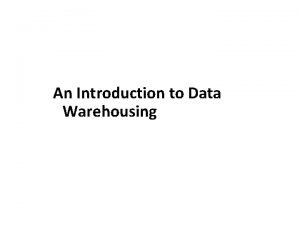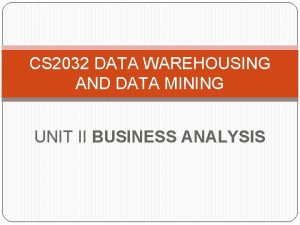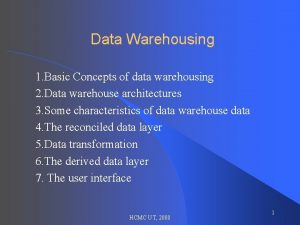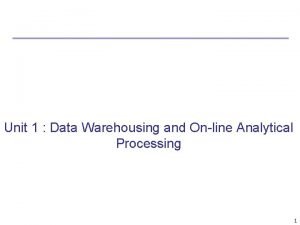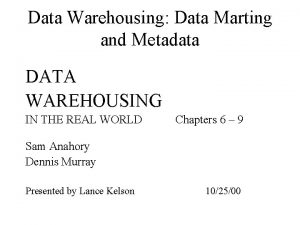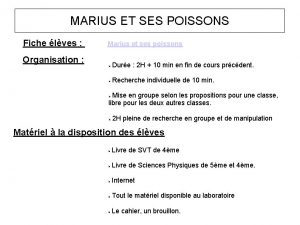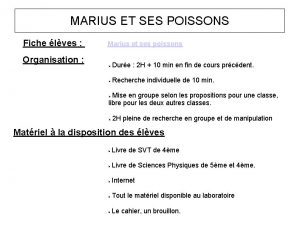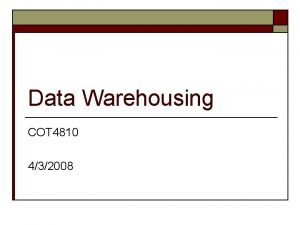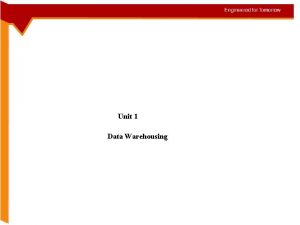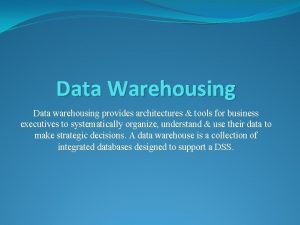My SQL Data Warehousing Survival Guide Marius Moscovici































- Slides: 31

My. SQL Data Warehousing Survival Guide Marius Moscovici (marius@metricinsights. com) Steffan Mejia (steffan@lindenlab. com)

Topics • The size of the beast • Evolution of a Warehouse • Lessons Learned • Survival Tips • Q&A

Size of the beast • 43 Servers o 36 active o 7 standby spares • 16 TB of data in My. SQL • 12 TB archived (pre S 3 staging) • 4 TB archived (S 3) • 3. 5 B rows in main warehouse • Largest table ~ 500 M rows (My. SQL)

Warehouse Evolution - First came slaving Problems: • Reporting slaves easily fall behind • Reporting limited to one-pass SQL

Warehouse Evolution - Then came temp tables Problems: • Easy to lock replication with temp table creation • Slaving becomes fragile

Warehouse Evolution - A Warehouse is Born Problems: • Warehouse workload limited by what can be performed by a single server

Warehouse Evolution - Workload Distributed Problems: • No Real-Time Application integration support

Warehouse Evolution - Integrate Real Time Data

Lessons Learned - Warehouse Design Workload exceeds available memory

Lessons Learned - Warehouse Design • Keep joins < available memory • Heavily Denormalize data for effective reporting • Minimize joins between large tables • Aggressively archive historical data

Lessons Learned - Data Movement • Mysqldump is your friend • Sequence parent/child data loads based on ETL assumptions o Orders without order lines o Order lines without orders • Data Movement Use Cases o Full o Incremental o Upsert (Insert on duplicate key update)

Full Table Loads • Good for small tables • Works for tables with no primary key • Data is fully replaced on each load

Incremental Loads • Table contains new rows but no updates • Good for insert-only tables • High-water mark level included in Mysqldump where clause

Upsert Loads • Table contains new and updated rows • Table must have primary key • Can be used to update only subset of columns

Lessons Learned - ETL Design • Avoid large joins like the plague • Break out ETL jobs into bite-size-bites • Ensure target data integrity on ETL failure • Use memory staging tables to boost performance

ETL Design - Sample Problem Build a daily summary of customer event log activity

ETL Design - Sample Solution

ETL Pseudo code - Step 1 1) Create staging table & Find High Water Mark: SELECT IFNULL(MAX(calendar_date), '2000 -01 -01') INTO @last_loaded_date FROM user_event_log_summary; set max_heap_table_size = <big enough number to hold several days data> CREATE TEMPORARY TABLE user_event_log_summary_staging (. . . ) ENGINE = MEMORY; CREATE INDEX user_idx USING HASH on user_event_log_summary_staging(user_id);

ETL Pseudo code - Step 2 2) Summarize events: INSERT INTO user_event_log_summary_staging ( calendar_date, user_id, event_type, event_count) SELECT DATE(event_time), user_id, event_type, COUNT(*) FROM event_log WHERE event_time > CONCAT(@last_loaded_date, '23: 59') GROUP BY 1, 2, 3;

ETL Pseudo code - Step 3 3) Set denormalized user columns: UPDATE user_event_log_summary_staging log_summary, user SET log_summary. type = user. type, log_summary. status = user. status WHERE user_id = log_summary. user_id;

ETL Pseudo code - Step 4 3) Insert into Target Table: INSERT INTO user_event_log_summary (. . . ) SELECT. . . FROM user_event_log_summary_staging;

Functional Partitioning • Benefits depend on o Partition Execution Times o Data Move Times o Dependencies between functional partitions

Functional Partitioning

Job Management • Run everything single-threaded on a server • Handle dependencies between jobs across servers • Smart re-start key to survival • Implemented 3 -level hierarchy of processing o Process (collection of build steps and data moves) o Build Steps (ETL 'units of work') o Data Moves

DW Replication • Similar to other My. SQL environments o Commodity hardware o Master-slave pairs for all databases • Mixed environments can be difficult o Use rsync to create slaves o But not with ssh (on private network) • Monitoring o Reporting queries need to be monitored § Beware of blocking queries § Only run reporting queries on slave (temp table issues) o Nagios o Ganglia o Custom scripts

Infrastructure Planning • Replication latency o Warehouse slave unable to keep up o Disk utilization > 95% o Required frequent re-sync • Options evaluated o Higher speed conventional disks o RAM increase o Solid-state-disks

Optimization • Check / reset HW RAID settings • Use general query log to track ETL / Queries • Application timing o isolate poor-performing parts of the build • Optimize data storage - automatic roll-off of older data

Infrastructure Changes • Increased memory 32 GB -> 64 GB • New servers have 96 GB RAM • SSD Solution o 12 & 16 disk configurations o RAID 6 vs. RAID 10 o 2. 0 T or 1. 6 TB formatted capacity o SATA 2 HW BBU RAID 6 o ~ 8 TB data on SSD

Results • Sometimes it pays to throw hardware at a problem o 15 -hour warehouse builds on old system o 6 hours on optimized system o No application changes

Finally. . . Archive Two-tiered solution • Move data into archive tables in separate DB • Use select to dump data - efficient and fast • Archive server handles migration o Dump data o GPG o Push to S 3

Survival Tips • Efforts to scale are non-linear o As you scale, it becomes increasingly difficult to manage o Be prepared to supplement your warehouse strategy § Dedicated appliance § Distributed processing (Hadoop, etc) • You can gain a great deal of headroom by optimizing I/O o Optimize current disk I/O path o Examine SSD / Flash solutions o Be pragmatic about table designs • It's important to stay ahead of the performance curve o Be proactive - monitor growth, scale early • Monitor everything, including your users o Bad queries can bring replication down
 Pseudo-marius
Pseudo-marius Modelo genetico de influencia social
Modelo genetico de influencia social Moscovici 1961
Moscovici 1961 Sherif esperimento campo estivo
Sherif esperimento campo estivo State of survival survival of the fittest tweak
State of survival survival of the fittest tweak State of survival survival of the fittest stages
State of survival survival of the fittest stages Data mining in data warehouse
Data mining in data warehouse Hadoop hive architecture
Hadoop hive architecture Datamart olap
Datamart olap Olap
Olap Data warehousing best practices
Data warehousing best practices Introduction to data warehousing and data mining
Introduction to data warehousing and data mining Software project survival guide pdf
Software project survival guide pdf Picu survival guide
Picu survival guide Tetris
Tetris Introduction to data warehouse
Introduction to data warehouse Coffing data warehousing
Coffing data warehousing Data warehousing components
Data warehousing components How to plan a data warehouse project
How to plan a data warehouse project Human thought process
Human thought process Data warehousing principles
Data warehousing principles Chicago time
Chicago time Introduction of data warehouse
Introduction of data warehouse An overview of data warehousing and olap technology
An overview of data warehousing and olap technology Concept hierarchy in data warehousing
Concept hierarchy in data warehousing Cs 2032
Cs 2032 Basic concept of data warehousing
Basic concept of data warehousing Inmon cif
Inmon cif Data warehouse terminology
Data warehouse terminology Healthcare data warehouse schema
Healthcare data warehouse schema Data warehousing and online analytical processing
Data warehousing and online analytical processing Inmon cif
Inmon cif
